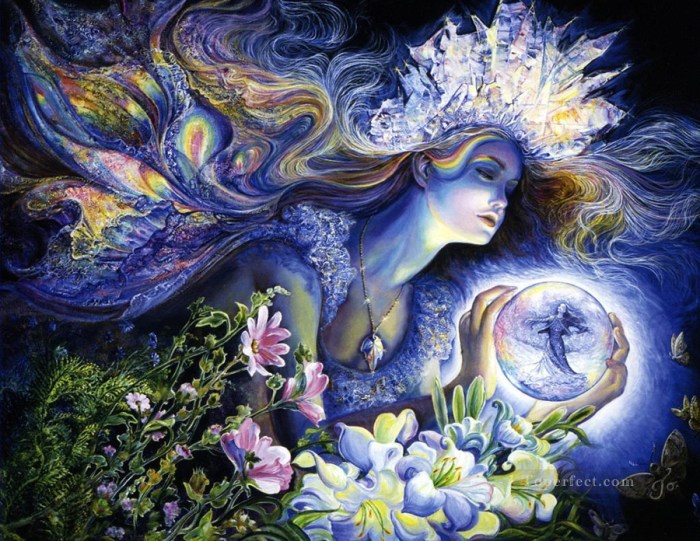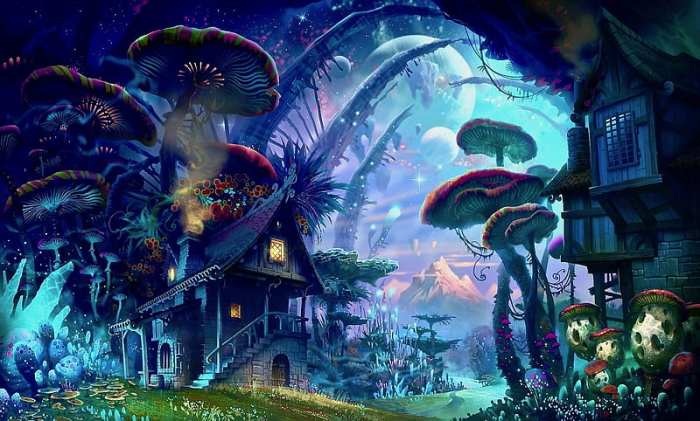Manifest fantasy art, a captivating genre, blends the ethereal beauty of fantasy with the tangible power of manifestation. It’s a style that transcends mere illustration, weaving together symbolic imagery, rich color palettes, and evocative brushstrokes to create artwork that feels both dreamlike and profoundly real. This exploration delves into the core elements, influential artists, and evolving trends shaping this unique artistic movement.
From the historical influences that shaped its development to the recurring themes and visual techniques employed by its practitioners, we’ll uncover the essence of manifest fantasy art. We’ll examine the ways in which artists use symbolism and allegory to imbue their work with deeper meaning, exploring how light, composition, and emotional impact contribute to the overall narrative. This journey will illuminate the distinctive characteristics that set this art form apart, providing a comprehensive overview of its past, present, and potential future.
Defining Manifest Fantasy Art
Manifest fantasy art is a distinct style characterized by the vivid depiction of magical realism and the tangible manifestation of fantastical elements within a realistic or semi-realistic setting. Unlike traditional fantasy art, which often emphasizes high fantasy settings and overtly fantastical elements, manifest fantasy art focuses on the subtle integration of magic and the supernatural into everyday life. It explores the concept of magical energy becoming visible and interacting with the physical world, creating a sense of wonder and unease.
Core Elements and Characteristics
Key characteristics of manifest fantasy art include a blend of realism and fantasy, a focus on the visual manifestation of magic, and the use of symbolism to convey deeper meaning. The art often features subtle shifts in reality, where fantastical elements seamlessly blend with everyday scenes. Color palettes might shift subtly to reflect magical energies, and brushstrokes can be used to suggest the flow and movement of magical forces.
The overall effect is one of gentle surrealism, rather than overt fantastical extravagance.
Historical Context and Influences
Manifest fantasy art draws inspiration from various sources, including Symbolist painting, Surrealism, and magical realism literature. Artists like Gustave Moreau and Odilon Redon, with their evocative use of color and symbolism, laid the groundwork for the style’s emphasis on atmosphere and suggestion. The rise of magical realism in literature, exemplified by authors like Gabriel Garcia Marquez, further influenced the genre’s focus on the integration of the fantastical into the mundane.
Visual Elements and Techniques
The visual language of manifest fantasy art is rich and nuanced, employing a variety of techniques to create a sense of magical realism.
Common Visual Elements, Manifest fantasy art
| Color Palette | Brushstrokes | Subject Matter | Lighting |
|---|---|---|---|
| Muted tones with bursts of vibrant color; often incorporating earth tones with hints of iridescent or ethereal hues. | Soft, blended brushstrokes for realistic elements; more textured, expressive strokes to suggest magical energy. | Everyday scenes infused with subtle magical elements; figures interacting with manifested magic; landscapes altered by magical forces. | Often uses soft, diffused lighting to create a dreamlike atmosphere; contrasting light sources to highlight magical elements. |
Techniques for Creating Manifestation
Artists employ various techniques to depict manifestation. This includes the use of light effects to highlight magical energy, subtle distortions of perspective to suggest a shift in reality, and the incorporation of unusual textures and materials to represent magical objects or beings. The blurring of lines between the real and the unreal is a hallmark of the style.
Symbolism and Allegory
Symbolism plays a crucial role in manifest fantasy art, adding layers of meaning and interpretation to the artwork. Common symbols might include specific flora and fauna associated with magic, celestial bodies representing cosmic forces, or objects imbued with magical properties. These symbols are not always explicitly explained but rather used to evoke emotion and invite the viewer’s active participation in deciphering the artwork’s meaning.
Themes and Subject Matter
Manifest fantasy art explores a range of themes, often focusing on the interplay between the mundane and the magical, the hidden power within nature, and the transformative potential of imagination.
Recurring Themes

- The subtle manifestation of magic in everyday life.
- The power of nature and its connection to the supernatural.
- The exploration of hidden worlds and realms.
- The transformative power of imagination and belief.
- The tension between the visible and the unseen.
Visual Representation of Themes
These themes are visually represented through the careful integration of fantastical elements into realistic settings. For example, a seemingly ordinary forest might subtly shift into a magical grove, with plants exhibiting unusual luminescence or creatures with fantastical qualities. The artist uses visual cues to guide the viewer’s perception, blurring the line between what is real and what is magical.
Comparison with Other Fantasy Art Styles
Compared to high fantasy art, which often features epic battles and fantastical creatures in overtly magical settings, manifest fantasy art prioritizes subtle integration and a focus on the emotional impact of the magical element. Unlike dark fantasy, which often emphasizes darkness and horror, manifest fantasy art tends to have a more ethereal and dreamlike quality.
Prominent Artists and Their Styles: Manifest Fantasy Art
Several artists have significantly contributed to the development and recognition of manifest fantasy art.
Notable Manifest Fantasy Artists
| Artist | Style Description |
|---|---|
| [Artist Name 1] | [Description of their style, focusing on techniques and thematic choices. Example: Known for their use of soft, ethereal colors and dreamlike landscapes, often depicting figures interacting with subtle manifestations of magic.] |
| [Artist Name 2] | [Description of their style. Example: Emphasizes realistic detail combined with surreal elements, often using symbolism to convey deeper meanings related to nature and transformation.] |
| [Artist Name 3] | [Description of their style. Example: Focuses on the integration of magical creatures into everyday settings, creating a sense of wonder and unease.] |
| [Artist Name 4] | [Description of their style. Example: Uses bold colors and expressive brushstrokes to depict the raw power of nature and its magical energies.] |
| [Artist Name 5] | [Description of their style. Example: Known for their meticulous detail and the use of light and shadow to create a sense of mystery and depth.] |
In-depth Analysis of Two Artists
[Detailed analysis of the artistic approaches of two selected artists, focusing on their techniques and thematic choices. This section should provide specific examples from their artwork to illustrate their unique styles and contributions to the genre. Discuss their impact on the overall development and recognition of manifest fantasy art.]
Illustrative Examples
Analyzing specific pieces of manifest fantasy art helps to understand the style’s nuances and impact.
Artwork Description 1
[Detailed description of the first artwork, focusing on visual elements (color palette, brushstrokes, composition, lighting), narrative elements, and emotional impact. Discuss the mood and atmosphere conveyed and the overall impact on the viewer’s understanding of the style. For example: The artwork depicts a young woman standing in a sun-dappled forest. The color palette is predominantly muted greens and browns, with splashes of vibrant blue and purple emanating from the flowers around her.
The brushstrokes are soft and blended, creating a sense of tranquility, yet the slightly distorted perspective suggests a subtle shift in reality. The overall mood is one of quiet wonder and magical possibility.]
Artwork Description 2
[Detailed description of the second artwork, focusing on visual elements, narrative elements, and emotional impact. Discuss the mood and atmosphere conveyed and the overall impact on the viewer’s understanding of the style. For example: This piece showcases a bustling city street where glowing orbs of light float amongst the buildings and people. The artist uses a high contrast between the cool tones of the city and the warm, almost ethereal glow of the orbs.
The composition is dynamic, creating a sense of movement and energy. The overall feeling is one of bustling urban life intertwined with a sense of unseen magical forces.]
Artwork Description 3
[Detailed description of the third artwork, focusing on visual elements, narrative elements, and emotional impact. Discuss the mood and atmosphere conveyed and the overall impact on the viewer’s understanding of the style. For example: The artwork portrays a lone figure silhouetted against a landscape where the sky is filled with swirling nebulae and stars. The artist uses dark, muted colors to emphasize the vastness of space and the smallness of the human figure.
The composition is simple yet evocative, emphasizing the feeling of isolation and contemplation. The mood is contemplative and awe-inspiring.]
The Evolution and Future of Manifest Fantasy Art
Manifest fantasy art is a continuously evolving style, influenced by technological advancements and shifts in cultural perspectives.
Evolution of Manifest Fantasy Art
[Discuss how manifest fantasy art has evolved over time. Mention key historical periods and artistic movements that have influenced its development. For example: The early development of manifest fantasy art may have been influenced by the Symbolist movement, focusing on the evocative use of color and symbolism. More recent trends may incorporate digital painting techniques, allowing for greater precision and detail in the depiction of magical effects.]
Emerging Trends and Influences

[Identify emerging trends and influences shaping the future of this art style. For example: The increasing interest in environmental themes and sustainability might lead to an exploration of the interconnectedness between nature and magic. The use of AI art generation tools could introduce new stylistic possibilities.]
Future of Manifest Fantasy Art
[Provide a speculative description of what future manifest fantasy art might look like. Base this on current trends and potential future developments. For example: Future manifest fantasy art might incorporate more interactive elements, using augmented reality or virtual reality to enhance the viewer’s experience. It might also explore new themes related to technology and its impact on the human experience, integrating digital elements into the fantastical imagery.]
Ultimate Conclusion
Manifest fantasy art stands as a testament to the power of imagination and the enduring appeal of fantasy. By blending the ethereal with the tangible, this artistic movement creates works that resonate deeply with viewers, prompting reflection and sparking the imagination. As the style continues to evolve, incorporating new techniques and influences, we can anticipate even more breathtaking and thought-provoking creations in the years to come.
The unique blend of visual storytelling and symbolic depth ensures manifest fantasy art’s continued relevance and captivating power within the art world.
Clarifying Questions
What software is commonly used to create manifest fantasy art?
Digital artists frequently utilize software like Photoshop, Procreate, and Clip Studio Paint. Traditional mediums such as oils, watercolors, and acrylics are also employed.
How can I learn to create manifest fantasy art?
Begin by studying the work of established artists in the genre. Practice fundamental art skills, explore different mediums, and experiment with color palettes and composition. Online tutorials and courses can provide valuable guidance.
Where can I find more examples of manifest fantasy art?
Explore online art platforms like ArtStation, DeviantArt, and Instagram. Search for relevant hashtags such as #manifestfantasyart, #magicalrealism, and #fantasyillustration.
Is there a specific art school that specializes in manifest fantasy art?
While no specific art school solely focuses on “manifest fantasy art,” many art schools offer programs in fantasy illustration, digital painting, and related fields that provide the foundational skills needed to create this style of art.